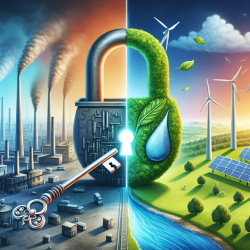In a world where industrialization often leads to environmental degradation, the concept of Cleaner Production (CP) emerges as a beacon of hope. The recent study titled "Opportunities and constraints for cleaner production policy in the developing world: a case study of Sindh Region, Pakistan" sheds light on how CP can be a game-changer for developing regions. This blog will explore the key findings of this study and provide actionable insights for practitioners looking to enhance their skills and contribute to sustainable development.
The Promise of Cleaner Production
Cleaner Production is a strategic approach that focuses on reducing waste and emissions at the source rather than relying on end-of-pipe solutions. By integrating CP practices, industries can achieve greater resource efficiency, reduce environmental impact, and enhance economic performance. The Sindh region in Pakistan serves as a compelling case study for understanding the opportunities and challenges of implementing CP policies in developing countries.
Key Findings from the Sindh Case Study
- Stakeholder Engagement: The study highlights the importance of involving key stakeholders such as government agencies, NGOs, academia, and industry leaders in the development and implementation of CP policies. This collaborative approach ensures that diverse perspectives are considered, leading to more effective policy outcomes.
- Financial and Institutional Support: One of the major barriers to CP adoption is the lack of financial resources and institutional support. The study emphasizes the need for government incentives, subsidies, and partnerships with international organizations to facilitate the transition to cleaner production methods.
- Capacity Building: Training programs for managers and workers are crucial for building the necessary skills and knowledge to implement CP practices effectively. The study suggests that tailored training sessions can help overcome resistance to change and foster a culture of sustainability within organizations.
Opportunities for Practitioners
The insights from this research provide valuable guidance for practitioners aiming to improve their skills in promoting cleaner production. Here are some steps you can take:
- Engage with Stakeholders: Build relationships with key stakeholders in your region to understand their needs and concerns regarding CP implementation. Collaborative efforts can lead to more comprehensive and effective solutions.
- Advocate for Policy Support: Work with policymakers to advocate for financial incentives and institutional support that can facilitate CP adoption. Highlight successful case studies from other regions to demonstrate the potential benefits.
- Pursue Continuous Learning: Stay informed about the latest developments in CP practices through conferences, webinars, and publications. Continuous learning will equip you with the knowledge needed to implement innovative solutions.
The journey towards cleaner production is not without its challenges, but with concerted efforts from practitioners, policymakers, and stakeholders, it is possible to create a more sustainable future. To read the original research paper, please follow this link: Opportunities and constraints for cleaner production policy in the developing world: a case study of Sindh Region, Pakistan.










